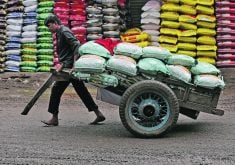Slow season sales | Trying to move a glut of grain during winter makes farmers vulnerable
Farmers will see something this spring and summer that almost never happens in the prairie grain business: rail car shipments running at a record pace.
It’s good for moving the present backlog, but grain company and railway executives also think it exposes an annual missed opportunity to reduce farmer vulnerability and potential system breakdowns.
“It’s an opportunity going forward,” Cargill Canada president Jeff Vassart said April 16 in an interview during the Canadian Global Crops Symposium.
“I think that’s one of the reasons we feel so confidently that we can do more. How do you utilize that back half of the year?”
Read Also

Phosphate prices to remain high
Phosphate prices are expected to remain elevated, according to Mosaic’s president.
Grain car flow in a normal crop year looks like a head and shoulders pattern on a chart. There are low, relatively flat periods at both the start and the end of the crop year, when relatively few cars are hauling grain. And then there is a big bulge in the middle months of September to March, when all the grain that grain companies can ship is shipped.
Canadian National Railways executive vice president Jean-Jacques Ruest said moving more grain in those “shoulder” periods is key to reducing vulnerability to winter congestion and system breakdown.
“One needs to take that risk (of winter breakdown or slowdown) into account.”
Ruest said CN wants to be “running flat-out” for the rest of this crop year and into the early weeks of next crop year. However, it also hopes grain companies are able to move more grain in the traditionally slow months of future years.
Vassart said Cargill shares that vision and hopes large farmer investments in state-of-the-art storage can give grain companies better options for spring and summer sales.
“We see farmers making significant investments to be able to continue to utilize the supply chain through that (spring and summer window), and we have the infrastructure too.”
He said farmers now have good, aerated bin systems that are located where trucks can reach them in spring, when road bans and other problems make it difficult to move grain off the farm.
The challenge now is to get it all connected for late crop year deliveries so that slower periods can provide an outlet for the busy winter season, he added.
“Historically, what we’ve seen is that we get to February forward and we’re not fully utilizing all the capacity that we have,” said Vassart.















